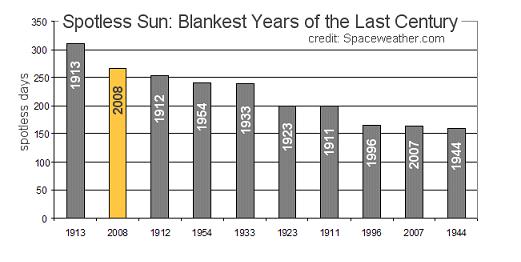
© Spaceweather.com
The year 2009 has moved into 8th place in the rankings of years with the most sunspot-free days since 1900.
The top 10 are shown in the accompanying graph; three of these have been in the past three years.
In fact, 2008, which was the quietest solar year in a century, could be bettered by 2009. If 70% of the remaining days in 2009 are sunspot free, we'll pass 2008, bumping it into 3rd place. The greatest number of sunspot free days since the year 1900 was in 1913, with approx. 320. The math shows that this record at least is safe for another year.
Another measure of solar sleep is the 10-centimeter radio flux streaming out from the nearest star to Earth. This too has been at very low levels in 2009, continuing the trend of the past two years. Much research shows that lower solar "wind" leads to more intergalactic particles reaching the earth's surface, and possibly more cloud formation. Perhaps this is how solar changes relate to Earth temperatures. More particles provide more collection sites for water vapor to condense, hence more clouds.
Some people have said that there is a correlation between this year's stone quiet hurricane season and the persistently slow solar output, but there is no empirical data to support this.
While there is probably some influence on the longer-term ocean temperatures (roughly correlated with the 11-year solar cycle) as related to solar variance, this year's tropical downturn is more likely a result of persistent wind shear over the tropics and slightly cooler than average sea temperatures.